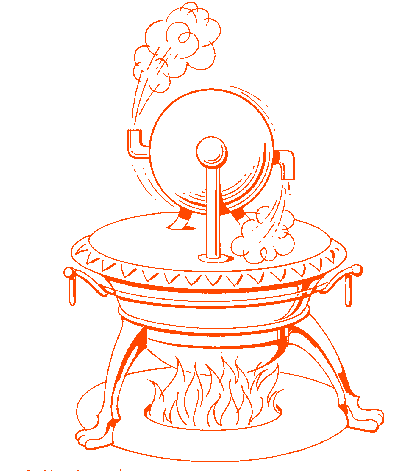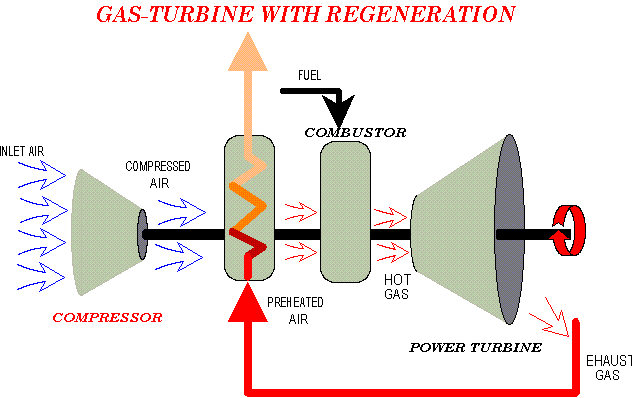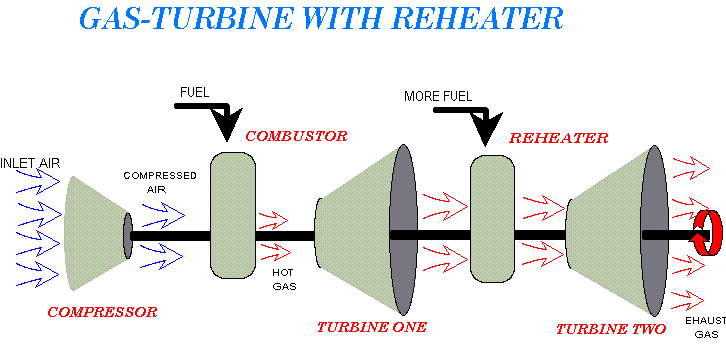Primer
The Gas Turbine Primer
This section is provided as an educational service to people of all ages and professions who are
interested in gas-turbine operation and theory. We feel it is in the best interest of the
gas-turbine industry to educate the general population about this technology since it is a
major power source used in the generation of electricity, and the power plant of choice for
modern aircraft and way-cool boats.
GAS-TURBINE THEORY
However, there are variations...
One variation of this basic cycle is the addition of a regenerator. A gas-turbine with a regenerator (heat exchanger) recaptures some of the energy in the exhaust gas, pre-heating the air entering the combustor. This cycle is typically used on low pressure ratio turbines.
Turbines using this cycle are: Solar Centaur / 3500 horsepower class up to the General Electric Frame 5 Gas-turbines with high pressure ratios can use an intercooler to cool the air between stages of compression, allowing you to burn more fuel and generate more power. Remember, the limiting factor on fuel input is the temperature of the hot gas created, because of the metallurgy of the first stage nozzle and turbine blades. With the advances in materials technology this physical limit is always climbing.

One turbine using this cycle is: General Electric LM1600 / Marine version A gas-turbine employing reheat.
The history of the gas turbine begins with a quest for jet
propulsion.
 The earliest example of jet propulsion can be
traced as far back as 150 BC to an Egyptian named Hero.
(Actually Hero was Hellenic not Egyptian. Thanks to Steve Mavrakis for pointing this out.)
Hero invented a machine that rotated on top of a boiling pot due to the reaction effect of hot
air or steam exiting several nozzles arranged radially around a wheel. He called this
invention an aeolipile.
The earliest example of jet propulsion can be
traced as far back as 150 BC to an Egyptian named Hero.
(Actually Hero was Hellenic not Egyptian. Thanks to Steve Mavrakis for pointing this out.)
Hero invented a machine that rotated on top of a boiling pot due to the reaction effect of hot
air or steam exiting several nozzles arranged radially around a wheel. He called this
invention an aeolipile.In 1232 the Chinese used rockets to frighten enemy soldiers and horses.
Around 1500 A.D. Leonardo da Vinci drew a sketch of a device that rotated due to the effect of hot gasses flowing up a chimney. The device was intended to be used to rotate meat being roasted. In 1629 another Italian named Giovanni Branca actually developed a device that used jets of steam to rotate a turbine that in turn was used to operate machinery. This was the first practical application of a steam turbine.

Ferdinand Verbiest
a Jesuit in China built a model carriage that used a steam jet for power in 1678. The first patent for a turbine engine was granted in 1791 to an Englishman named John Barber. It incorporated many of the same elements of a modern gas turbine but used a reciprocating compressor. There are many more early examples of turbine engines designed by various inventors, but none were considered to be true gas turbines because they incorporated steam at some point in the process.
In 1872 a man by the name of Stolze designed the first true gas turbine. His engine incorporated a multistage turbine section and a multi stage axial flow compressor. He tested working models in the early 1900's. Charles Curtis the inventor of the Curtis steam engine filed the first patent application in the U.S. for a gas turbine engine. His patent was granted in 1914 but not without some controversy. The General Electric company started their gas turbine division in 1903. An engineer named Stanford Moss lead most of the projects. His most outstanding development was the General Electric turbo supercharger during world war 1. ( Although credit for the concept is given to Rateau of France.) It used hot exhaust gasses from a reciprocating engine to drive a turbine wheel that in turn drove a centrifugal compressor used for supercharging. The evolutionary process of turbo supercharger design and construction made it possible to construct the first reliable gas turbine engines. Sir Frank Whittle of Great Britain patented a design for a jet aircraft engine in 1930.He first proposed using the gas turbine engine for propulsion in 1928 while a student at the Royal Air Force College in Cranwell, England. In 1941 an engine designed by Whittle was the first successful turbojet airplane flown in Great Britain. Concurrently with Whittle's development efforts, Hans von Ohain and Max Hahn, two students at Gottingen in Germany developed and patented their own engine design in 1936 these ideas were adapted by The Ernst Heinkel Aircraft company. The German Heinkel aircraft company is credited with the first flight of a gas turbine powered jet propelled aircraft on August 27th 1939.The HE178 was the first jet airplane to fly.
The Heinkel HeS-3b developed 1100 lbs. of thrust and flew over 400 mph, later came the ME262, a 500 mph fighter, more than 1600 of these were built by the end of WWII. These engines were more advanced than the British planes and had such features as blade cooling and a variable area exhaust nozzles.
In 1941Frank Whittle began flight tests of a turbojet engine of his own design in England. Eventually The General Electric company manufactured engines in the U.S. based on Whittle's design.
To be continued ...... information courtesy Ron Munson



